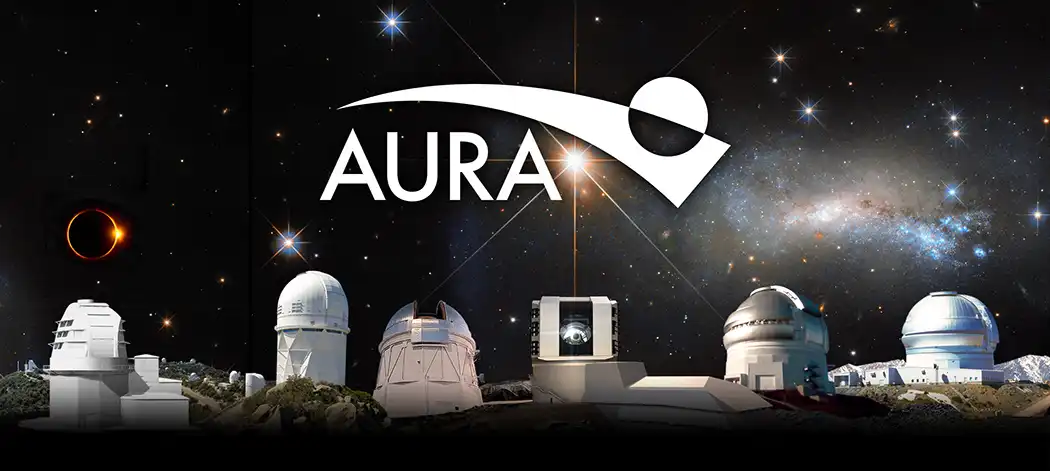Mayor Arakawa: State of the County is “One of Perpetual Change”
Maui Mayor Alan Arakawa delivers his 2016 State of the County Address tonight before a full house at the McCoy Studio Theater at the Maui Arts and Cultural Center saying the state of Maui County “is one of perpetual change.” The address highlights the County’s achievements in 2015, as well as plans for the coming year.
Scroll down below to view a complete text of the Mayor’s State of the County Address.
The Mayor discussed the expected loss of 650 jobs before the end of the year due to the cessation of sugar operations at Hawaiian Commercial & Sugar Company. Other recent issues facing the county include the 5,000 acre brushfire at Kahikinui, severe flooding that forced the closure of the main DMV service center in Kahului, and a road that the Mayor said, “threatens to slip into the ocean,” in East Maui.
The Mayor also highlighted accomplishments from the past year saying a third of the county’s 900 miles of roads have been improved over the last five years.
In touching on the issue of homelessness, Mayor Arakawa said there is a proposal before the council to purchase state-of-the-art emergency housing units from the mainland that could accommodate hundreds of homeless individuals and families. He said, “Keep in mind that these are not tents. These are portable, durable, modernly designed living spaces with a locking door, four walls and a roof.”
State of the County 2016 – by Mayor Alan M. Arakawa
“Aloha, and good evening. Thank you for joining us here tonight, both those present in the studio and those watching from home.
Mahalo to the Maui Arts and Cultural Center for once again hosting us in the beautiful McCoy Theater. Special thanks also goes out to Akaku Public Access television for the wonderful service they provide.
Thanks to Akaku, tonight’s broadcast can be seen on Channel 53 and on a live-stream at Akaku.org.
We would also like to thank our Hawaii News Now for preempting their regular programing so that they can broadcast our neighbor island State of the County address live for the first time on network television.
To take advantage of that we are presenting this year’s State of the County later in the evening, when more working people are home and able to watch it.
For everyone in the audience and at home I’d like to start this year’s speech by saying that as mayor, my guiding principal has been to do the most important tasks that our community has asked us to do.
Over the years we’ve done our best to either do it, fix it or plan for it.
These tasks include road improvements, new parks, affordable housing and helping to transition our homeless population off of the streets. Reliable public transportation, clean water, well planned out communities and sound investment of our taxpayer dollars.
Like any operation, we plan for everything we can plan for.
For those we can’t, we respond as best as we can.
On that note 2016 has been a very busy year so far.
There is a five thousand acre brushfire that is still going on, water damage that’s closed our main DMV service center and a road that threatens to slip into the ocean.

HC&S final harvest. Photo: Chris Archer.
And let’s not forget the loss of 650 jobs due to the end of HC&S sugar operations.
So if you ask what the State of the County is today, it is one of perpetual change. Things are moving fast here and government must evolve if we want to keep up.
We did it with our roads. For years the county had been falling behind our own road maintenance schedule.
That is no longer the case. Maui County has a total of 900 road miles, and we’ve improved a third of those roads over the last five years. They include Kokomo and Hansen Roads, Baldwin and Lono avenues, South Kīhei Road, Kahikili Highway and many more.

Papa Avenue construction in Kahului. Photo by Wendy Osher.
We have repaved some, preserved some, and other roads we have been able to totally reconstruct from the ground up with the help of federal transportation funds.
We’ve also been improving the conditions at our parks, because as our population grows so do park demands.
Recently my parks director said he was told by other county park directors that we have some of the best playing fields in the state right here in Maui County.
I have to agree with them, and we want to continue to make them better.
Our improvements include fixing everything from park irrigation systems, gymnasiums, community centers, playgrounds, pools, tennis courts and even the lights at our ball parks. We are continuing to improve our park restrooms countywide to make sure they are clean and sanitary for everyone to use.
We are working towards truly having a countywide park system with roughly three times the number of playing fields currently – up from 200 to 600 acres altogether. The projects are located in all sections of the county including Upcountry, Hāna, Molokaʻi, Lānaʻi, East, West, South and Central Maui.
Some of these projects include new gyms, new parks, new ball fields as well as upgrading already existing facilities.
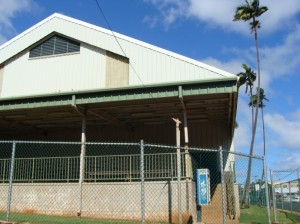
Old Wailuku Gym. Photo by Wendy Osher.
Old Wailuku Gym for example has had a $1.2 million dollar facelift and looks better than ever.
The same goes for the Lānaʻi Gymnasium – the island’s only gym – which will be closed for the next 30 days while we make some much needed repairs.
On Molokaʻi we are looking to build a new gym, one that will serve as an emergency shelter as well.
This new Molokaʻi gym will be built to meet the guidelines of FEMA, the Federal Emergency Management Agency, so it can be used during tsunami and hurricane events, as well as qualify for federal funding.

Central Maui Regional Sports Complex grand opening and blessing event (3/12/16). Photo credit: DLNR.
On Maui, we kicked off the first phase of Central Maui Regional Park in Kahului with the Maui Girls Softball Association season opener this past weekend.
Once this park is complete it will feature four softball fields, four little league baseball fields, three soccer fields and a multi-sports field. This $25 million park was funded by the
State of Hawaiʻi and turned over to the county thanks to our Lieutenant Governor Shan Tsutsui.
For any growing community, parks are not a luxury, they are a necessity.
But even more important to a community than parks is housing, because without housing people end up sleeping in our parks.

Kulamalu affordable rental groundbreaking, Dec. 10, 2015. Debra Lordan photo.
For our residents we have already begun the Kulamalu Affordable Housing project.
This 56 unit affordable rental project in Pukalani will be eligible to individuals and families earning between 50 and 140 percent of Maui County’s area median income.
Once it is complete we believe it will be a neighborhood where our teachers, nurses, police officers and other middle-class earners will be able to rent a good home.
Certainly this project is not enough, but it is a start. We are already working with our local developers on other affordable housing projects which we hope will come to fruition in the very near future.
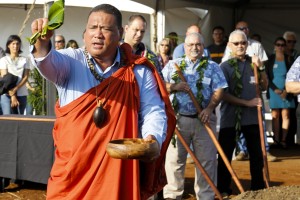
Kamalani groundbreaking led by Kaponoʻai Molitau on Jan. 14, 2016.
One is the Alexander and Baldwin subdivision in South Maui, and the other a Stanford Carr development in West Maui.
Without affordable housing, we force our children to move to somewhere else they can survive financially.
Our homeless population needs more immediate help. This is why we have a proposal before council to purchase state-of-the-art emergency housing units from the mainland that could accommodate hundreds of homeless individuals and families.
Keep in mind that these are not tents. These are portable, durable, modernly designed living spaces with a locking door, four walls and a roof.
Studies show that if society can provide a person with a real home with accompanying support services, they are given the privacy, safety and dignity they need to transition themselves out of the situation they are in.
In the long-run, providing supportive housing actually saves more money for the taxpayer – roughly 50 percent – when compared to the cost for the homeless to remain on the streets where they use our public services – our police, fire, emergency rooms and courtrooms – at a very high frequency.
Also, the housing units we are recommending will make it safer for our non-profit and social service workers to visit and provide services to these individuals. Often times we hear that workers have to deal with dogs, darkly lit camps, drug use and other obstacles to situation.
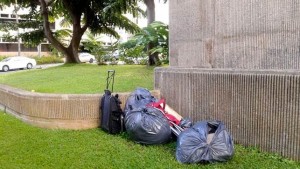
Photo credit: Maui Office of Council Services.
Other counties have already funded their homeless initiatives, and I hope our Maui County Council members will do the same.
So let’s get it done, especially while the Governor’s emergency proclamation to help us assist the homeless, is still in effect.
These are the tasks we were asked to address and we are.
Our Department of Water Supply for example will be building the much needed ʻĪao Water Surface Treatment plant this year.
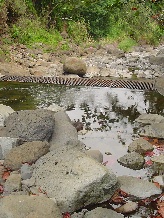
File photo of Wailuku River (ʻĪao Stream) in West Maui where stream diversions and water rights have been the subject of Water Commission reviews. Photo by Wendy Osher
This $15 million plant is necessary to clean the extra 1.5 million gallons a day that the county is to receive, due to the successful agreement of the Nā Wai ʻEha decision.
Construction is set to begin this year, thanks to the funds approved by our Maui County Council members.
Our Department of Transportation continues to make our public transportation more efficient. The Maui Bus has 2.4 million passenger boardings annually, and to meet increased ridership demands and replace its aging fleet, the county has purchased 16 new passenger buses.
Also, you can now track the Maui Bus in real time, using our Transloc Rider application on your phone. Just download it and you can see where your bus is and if it’s coming around the corner or a couple of blocks away.
Most importantly we will be completing our Maui County Short Range Transit Plan this year. This transit plan will enable us to map out the growing needs of our population.
With it we can figure out where we need more public transportation, where our traffic problems are and what our future needs will be.
We continue to plan for our future communities by purchasing open space along our shoreline to protect from development.
Not only does this preserve our beaches for future generations but it also protects people from building on properties that suffer from shoreline erosion and rising sea levels.
To do this the administration and the council have worked together over the years to purchase land in Launiopoko, Pāʻia and Paukūkalo. Combine those properties with others we have purchased, open space along with open space owned by the state, and Maui’s shorelines are protected from development from Pāʻia to Waiehu, and Lahaina to Wailea, which is roughly 80 percent of our north and south shores.
Development can still happen, but it has to take place inland. Our shorelines will be protected for generations to come. Mahalo to the state and our council members for helping to make this happen.
Despite what people think, the administration and the council do get things done. We just don’t always agree HOW to get things done.
I’d like to take this time to recognize our Maui County Council members, for continuing to be a shining example of how checks and balances are supposed to work in government.
I have to say though that sometimes your checks are like that of a chess player, and sometimes it is like that of a hockey player.
Maybe this year we should work on the “balances” part of the checks and balances equation? Just a suggestion.
Our Department of Finance and the Budget Office continues to earn top honors nationally for their work.
Because of their decisions Maui County once again has the highest bond rating in the state, double A plus.
We’re also using taxpayer dollars to make sound investments at minimal risk to our residents. Our county investments have a projected $3 million return this fiscal year, up $1.5 million from fiscal year 2015.
All of these benefits are the result of careful planning and execution. We have to do this, because it gives us some leeway to deal with the things we couldn’t plan for.
A perfect example is how the county has to pay for the emergency reconstruction of Piʻilani Highway in Kīpahulu, which threatens to slip into the ocean after a recent landslide.
That road was never intended to sustain heavy traffic, but each year we see more and more vehicles using that back road to Hāna. There was a time when visitors were too afraid to drive that way, and now there are daily tours.

Kahikinui Brush Fire as of 2.18.2016 (Photo: Ryan Piros)
Also tomorrow marks the 30th day that our fire fighters have been out on the other side of the island keeping the Kahikinui fire under control.
As of last week the department costs of fighting the fire were around $350,000, and that does not include helicopter flight time or overtime. Some of our other departments, such as Public Works, have also assisted fire fighters and have incurred their own costs.
While we do plan to apply for emergency money from FEMA, the county must be prepared to foot some of the bill.
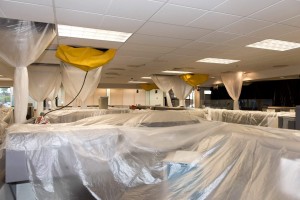
Storm-damaged offices at the Maui County Division of Motor Vehicles and Licensing. Photo credit: County of Maui / Ryan Piros.
And just last week we had to close down our main service center, the Kahului branch of the Division of Licensing and Motor Vehicles.
Rain damage flooded the entire division and we are looking for a temporary space nearby in order to service the public in Central Maui.
We assist an average of 340 customers a day at our Kahului service center, and we need to get temporary operations soon otherwise we’ll be facing a giant backlog very quickly.
Then there’s the end of the sugar industry on Maui.
Hundreds of workers from Hawaiian Commercial & Sugar will be let go by December. We anticipate other businesses which rely upon the work they get from the sugar plantation to be negatively impacted as well.
We couldn’t fit all of HC&S’ workers in McCoy Theater tonight but the company did select a few employees to represent them all. Please stand when you hear your name.
Jennifer McDonald is HC&S’ power plant supervisor, and she’s been keeping the lights on for 11 years now.
Koa Francis Martin has been a Millwright Specialist for 20 years, and part of the team that has fixed just about everything in the Pu’unene mill.
Clyde Anakalea started working in the sugar cane ditches 39 years ago, and now he’s a Maintenance Supervisor.
Elmer Manuel started cutting cane in the fields 44 years ago and now he’s a farm supervisor.
Finally Miguel Galicia is a Machinist Specialist for the Sugar Boiler. He’s been with HC&S for 45 years and is their most senior employee.
Let’s give all of them a round of applause for all of their hard work helping to keep the ag industry alive on Maui.
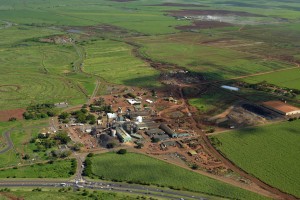
Alexander & Baldwin photo of HC&S Puʻunēnē mill and surrounding sugar fields. Courtesy image.
These workers and hundreds of others like them are the reason why we have formed the Sugar Operators Work Assistance Task Force. Headed by Managing Director Keith Regan, this group is dedicated to helping more than 650 plus workers find their new place in our community.
To do this the task force has been connecting workers to the many resources that are out there, that they might not otherwise know about. We are informing them about job fairs, educational opportunities, how to continue their health benefits, where to go for financial planning and how to apply for rental assistance so they can stay in their homes.
Most importantly, the task force has created an information clearinghouse to match potential employers with the right workers. There are many companies out there that want to hire skilled sugar employees and we are taking down their information so we can bring everyone together.
And we just learned today, that Senator Brian Schatz has made federal money available to help pay for job training, tuition, books and other costs to retrain our sugar workers.
Mahalo to Senator Schatz for his dedication to the people of Maui County.
One day perhaps, HC&S will be able to hire some of its workforce back. However that won’t be anytime soon.
For the next few years the company tells us that they will be running crop trials on their land, to determine what mix of new crops will work best.
As any farmer will tell you, diversified agriculture isn’t easy.
The varieties of crops you can grow in your backyard can’t be duplicated on a large scale, especially when you’re talking about tens of thousands of acres.
But there are some hopeful prospects – tropical grasses and oil producing seeds that could be used as bio-fuels; beverage crops such as cacao and coffee; fruit bearing orchards such as mango or avocado. One day some or all of these may become the new face of our central plain.
I know I speak for all of us in Maui County when I wish HC&S the very best in coming up with a line crops that are not only economically viable, but also environmentally sound.
Part of that crop diversification includes creating an agricultural park, which will offer some community farming opportunities.
Right now my office is taking down information from those who are interested in farming on HC&S land. We are looking for serious inquiries from those who would like to lease their land for agricultural purposes.
Besides contact information my office we will also be asking for a list of qualifications or a “farming resume” of sorts.
Our community has many different ideas and opinions about what the future of farming on Maui should be like, but the bottom line is we need more vegetable farmers. Period.
We need food crops if we want to be a sustainable community. We also need to keep our central plain green and our agricultural industry alive.
So farmers, now is the time to step up to the dinner plate. We’ve already had a good number of interested parties contact my office about ag opportunities, but to date we have not been contacted by one vegetable farmer yet.
I’ll say it slowly so everybody understands. We. Need. Vegetable farmers.
The Central Maui plain needs to stay green for our environment and our economy. For years now there have been only two major industries on Maui, agriculture and tourism.
Thankfully, our visitor numbers remain strong. Tourism is the backbone of our economy year after year, thanks to our natural beauty, the spirit of our people and the hard working visitor and hospitality industry.
But with any industry, our visitors come at a price, and take a toll on our infrastructure.
This is why we must all press upon the state legislature to ensure that Maui County, along with our sister counties,get a fairer share of the Transient Accommodations Tax or TAT.
I urge you to contact your state representative and let them know that you support the findings of the joint State-County
Functions Working Group, which recommended a compromise proposal last year that the counties get 45 percent of the TAT. Do it so that that tourism pays for more improvements in our community, and requires less of your tax dollars.
At this time I would like to recognize our state delegates here tonight, and thank them for all of their hard work and continued support for this community.
We need your help getting a true Lahaina bypass from Maalaea to Kapalua, a Paia bypass and to keep building the Kihei High School.
Also don’t forget about fighting for our fair share of the TAT.
Efficiency means everything in government, because we are using the taxpayer money to fund our operations.
Accountability is important as well, because if you aren’t being efficient, people want to know why.
For this reason we continue to move ahead with the proposed County Consolidated Baseyard in Waikapu. So far we have purchased the property, developed a site plan and are now having our departments master plan ways to reorganize and consolidate services.
Eventually these facilities will consolidate all of our baseyards in Central Maui, and get rid of duplicate services such as storage, processing, fueling and mechanic operations.
More importantly, we will increase accountability by having a Central Inventory for our equipment.
Over the last year or so, the Office of Corporation Counsel and our Police Department have been involved in several investigations of our own personnel from various departments, most of them involving alleged purchasing abuses.
You should know that the County of Maui is the largest employer in the county, with more than 2500 employees. It stands to reason that some employees are less honest than others.
Whenever there is any indication of wrongdoing we immediately begin investigating to determine if further action needs to be taken. The county takes any misuse of public money very seriously and will not tolerate abuse of the public trust.
Having Central Inventory at a Consolidated Baseyard will solve many purchasing issues.
In the meantime, I call upon all of our county supervisors to do spot audits of their workers and make sure their purchase orders match their job assignment.
The worst thing about bad employees, is that they cast a shadow over all employees. That’s a real shame, because the vast majority of Maui County employees are dedicated and hard-working public servants doing important work.
Our Maui Police Department continues to meet higher standards. By the end of the year MPD will be implementing body cameras for about 125 of its patrol officers.
Although some see these cameras as a way to monitor the behavior of our officers, they are also a tool for law enforcement.
Used correctly, we hope that the footage from these cameras can be used as evidence in court. Mahalo to
Chief Tivo for initiating this important community policing tool.
Our Maui County Civil Defense personnel continue to protect this community, by working very closely with the State
Department of Health, Maui District Health Office, to protect our community from having a dengue fever outbreak.
We had one case identified here on Maui this year, but it was a different strain that the one found in Hawaii County. That patient was isolated immediately while the health department launched their investigation.
In the meantime both the county and the state are developing a mosquito control education program.
It is important that you get rid of any standing water around your property where mosquitos can breed, and remember to protect yourself with insect repellent when you are outdoors.
Finally, I’d like to recognize another group of special guests in the audience tonight. Would all of our Vietnam Veterans please stand?
The Department of Defense has designated March 29, 2016 as a day to honor our Vietnam veterans for the 50th anniversary of the war. Locally here on Maui we had 42 of our young men who never returned home from Vietnam.
Tonight let us honor our all of our veterans, those who made it home, and those who did not. Those who are gathered here and wherever else they may be.
We will never forget your service and your sacrifice. Mahalo for all you have done.
Our veterans did what they had to do when called to duty, just as we need to do what this community has called us to do.
We have and we will continue to do our best to meet the needs of Maui County.
Road improvements, new parks, affordable housing and helping to transition our homeless population off of the streets. Reliable public transportation, clean water, well planned out communities and sound investment of our taxpayer dollars.
These are our needs, and our needs are growing because our home is growing. In fact our population is growing faster than anywhere else in the state.
In the year 2000 we had a little more than 117,000 people living here.
Fast forward to 2014 and now the U.S. Census estimates we have more than 163,000 people living in Maui County.
That’s the largest growth spurt in the history of our county.
In less than two decades our population increased by a third, more than 55,000 people.
We need to work together and direct that growth, otherwise that growth will direct us. It’s up to us to shape what our home will look like in the future.
Whatever happens, it will almost certainly be one of the best communities in the world. I know that, because it already is.
Thank you to everyone for all of your hard work in makingthis community a wonderful place. Special thanks goes to my wife Ann for helping me make it through another year.
She’s my head accountant, gourmet chef, master of my credit card and the real head executive here.
Maybe we can’t do everything. But there are plenty of things we can do if we concentrate on one problem at a time and work together.
Mahalo for all your hard work, aloha and God bless.”
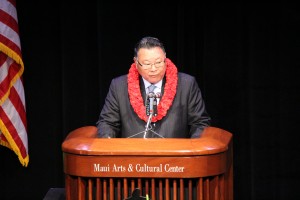
Maui Mayor Alan Arakawa. Photo by Wendy Osher.

Maui Mayor Alan Arakawa. Photo by Wendy Osher.

Maui Managing Director Keith Regan. Photo by Wendy Osher.
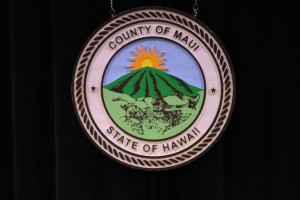
Photo by Wendy Osher.

Kimokeo Kapahulehua. Photo by Wendy Osher.

Maui Mayor Alan Arakawa. Photo by Wendy Osher.









